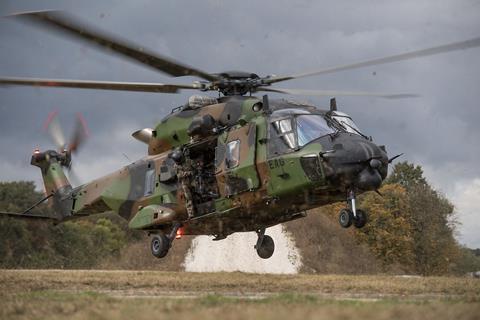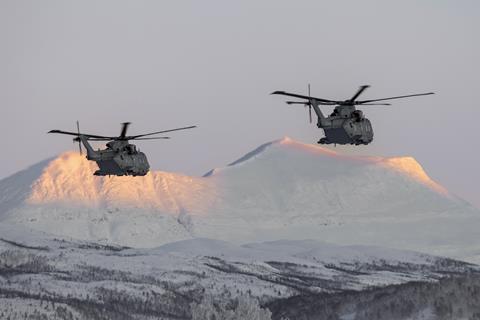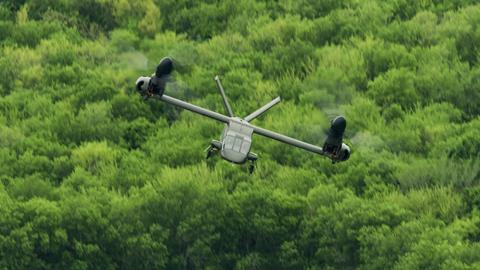Prototypes of a next-generation helicopter destined for NATO forces could be flying around 2030 if plans being touted by the alliance come to fruition.
A group of NATO nations – France, Germany, Greece, Italy, the Netherlands and the UK, plus Canada, which will join this year – are driving a project called Next Generation Rotorcraft Capability (NGRC) with the intention of fielding a new medium-class helicopter by 2035.

Currently in its early stages, a programme management office was set up in late 2022, run by the NATO Support and Procurement Agency (NSPA), which is managing the concept stage.
Work has now begun in earnest to launch the five concept studies that will shape the NGRC’s design. As part of that process, contracts will be awarded following competitive tenders to “one to three” contractors who will “answer this conceptual review by proposing a possible design for NGRC”, says Cyril Heckel, NGRC programme manager at the NSPA.
Those designs, potentially with options, alongside a “rough order of magnitude of through-life costs” are expected to be delivered in 2025, he says.
Although the steps required to move NGRC from a concept to a development programme are still to be discussed, Heckel sees a potential need for technology demonstrators to form part of that development effort.
“It will be my recommendation for the possible development stage that we have some prototyping activities,” he said, speaking on the sidelines of Defence IQ’s International Military Helicopter (IMH) conference in London on 22 February.
Given the uncertainties around NGRC’s schedule and future steps, Heckel says he cannot confirm when any such prototypes might fly, but concedes this is likely to happen “around 2030”.
Launching a full development programme would require further political agreement from the participating countries, with issues such as design, workshare, and the possible admission of other NATO members still to be addressed.
“These are topics we still have to tackle among the nations – they will be the ones driving the decision process aspects,” he says.
So far, detailed requirements for the NGRC have not been set. Instead a list of “attributes” was released in May 2021, including capacity for 12-16 fully equipped troops, unrefuelled range of 900nm (1,650km) and a spectrum of cruise speeds: “optimally” this would be 220kt (408km/h) or above, but must be “not less than 180kt”.
Speed may the most contentious of these attributes among the current member nations. Delegates at the IMH event were told that future rotorcraft for the Italian air force would need to travel at 250kt, while French army aviation would maintain its doctrine of nap-of-the-earth flights at around 100kt.
“We don’t see that high speed is an advantage. It is a problem of compromise – we cannot have it all. That is why we do not place high speed as our top priority,” says an official familiar with the French army’s thinking.

Heckel says the issue “remains open” and through the concept review phase high speed “is one of the attributes we want to explore, to test, and to see what is feasible”.
The impact of speed on the concept of operations (ConOps) being developed as part of NGRC’s first phase will also be evaluated, says Heckel, and could lead to further “evolution” of either the desired attributes or the ConOps itself, depending on where priorities lie.
According to the list of attributes, NGRC should address multiple missions, across multiple domains, with a single airframe and a modular approach.
Heckel says this remains the programme’s intention: “For the concept stage it’s good to keep in mind that we should target only one common airframe and to push for this modularity for NGRC.”
However, two variants could emerge “if we have a quantified justification” that this is the “best solution to tackle the entire spectrum of ConOps”.
Nonetheless, Heckel, mindful of the lessons learned from the development of the NH Industries NH90 – another NATO-led multi-national programme – wants the NGRC to avoid a multiplicity of country-specific variants which would lead to issues around sustainment.
“This configuration management can be a big challenge for nations. Our aim is to find common system to avoid a multiplication of variants and maximise cost effectiveness through commonality,” he says.
Five studies are planned as part of the concept stage: two to three will be open to industry – covering the powerplant, and an open systems architecture – plus the roughly 18-month-long concept review; development of the ConOps, and studies around disruptive technologies will be monitored by the NGRC programme office.
But the initial focus will around the powertrain: this study is to be launched in the coming weeks – a pre-solicitation conference will be held at end of March – and will conclude in late 2023 or early 2024.
Although NGRC participants are overwhelmingly drawn from Europe, because it is a NATO programme any procurements are open to companies from across the alliance – including those from the USA.

Crucially, that means US manufacturers Bell and Sikorsky could propose technologies or aircraft architectures matured through the US Army’s Future Vertical Lift programme.
Sikorsky has confirmed to FlightGlobal that intends to participate in the NGRC process, but Bell’s approach may be more nuanced given the selection – subject to protest – of its V-280 Valor tiltrotor by the army for its Future Long Range Assault Aircraft programme.
Assuming the protest is dismissed, by the time the NGRC enters service in 2035, “the V-280 will already be at full-rate production”, notes one company insider.
European industry is attempting to bridge what one executive describes as the USA’s “10-year and $5 billion headstart” through a separate technology maturation effort.
The European Next Generation Rotorcraft Technology (ENGRT) project, co-led by Airbus Helicopters and Leonardo Helicopters, has been allocated €40 million ($42 million) by the European Defence Fund for its phase one work.
Despite the presence of defence and aerospace companies from several NGRC member states within the ENGRT consortium, Heckel stresses there are no formal links between the two programmes.
“Can there be a link between the European and NATO initiatives today without a strong political willingness from nations? It’s not for [the NSPA] to answer this – I think decision will be made at a political level,” he adds.
Membership of the NGRC grouping will be limited to the current seven nations for the concept stage; the next opportunity to join will arrive in 2025 if a development programme is launched, says Heckel.































